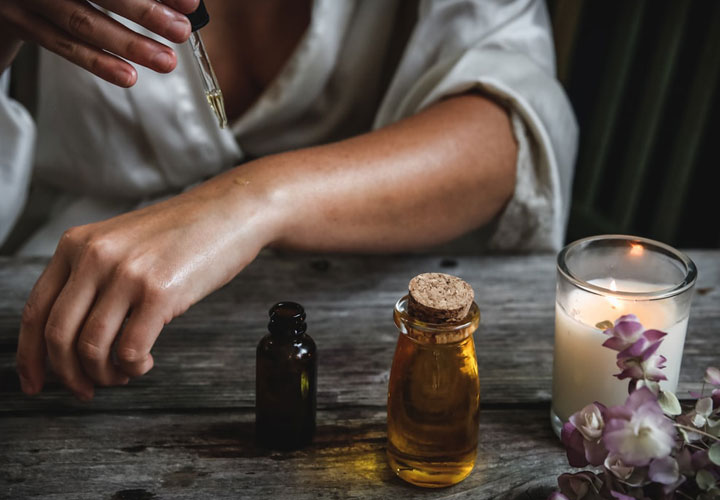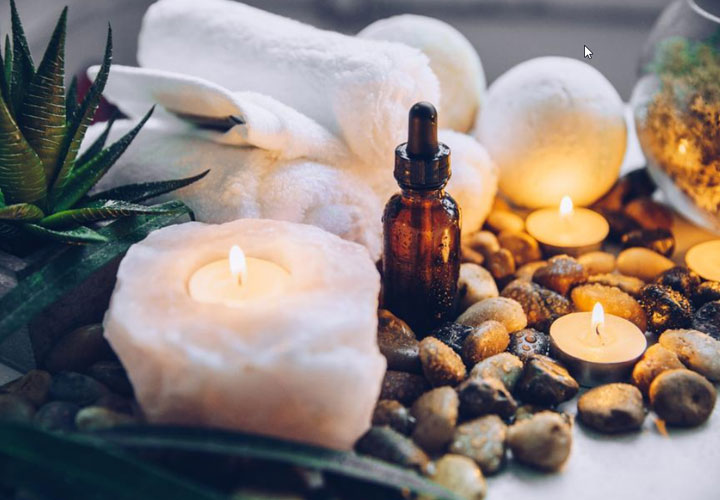Essential oils have been used for thousands of years as natural medicines. And even today, we can’t get enough of their benefits. They can help calm our anxious minds, boost our mood, improve the state of our hair and skin, and can even help your pup. But in order for an essential oil to have a real effect, you will need to make sure it’s high quality.
Essential oils are most potent when they are 100% pure. This means that they do not contain any synthetic components or carrier oils that can reduce their efficacy. But with so many products on the market, how do you know if essential oil is 100% pure? Just like in other industries, essential oil manufactures can be unreliable and charge you for something you’re not getting. But luckily, pure oils are easy to sniff out once you know what you should pay attention to. Here are some ways you can tell whether an essential oil is pure or not, even when online shopping.

It’s Stored in a Glass Bottle
When looking for a reliable product, pay attention to how it’s stored. Pure essential oils are always stored in glass bottles because they are so potent that they can break down plastic over time. Additionally, a pure oil will be sensitive to light and start to break down an lose its properties when exposed to light. For that reason, a pure essential oil is always sold in a dark coloured glass container. The best types of bottles are the ones that have an amber-brown or dark blue colour because these protect the oil best from the ultraviolet rays that can degrade it. So, when buying a pure essential oil, the first thing to do is to pay attention to the bottle.
Read the Lable
If you’ve found an oil that’s stored in a suitable bottle, the next step is to check its lable. The main difference between a pure oil and a diluted one is the presence of synthetic components or carrier oils. You want to avoid essential oils that contain any alcohol, as these do not bring any therapeutic benefits compared to pure oils. On the other hand, the lable of a pure oil won’t state any other ingredient besides the oil itself. In some cases, essential oils that have been diluted or otherwise tempered with will include the words “aromatherapy grade” or “fragrance grade” on them. This is a clear indication that you’re not looking at a 100% pure product.

Organic Is Not Always a Sign of Purity
Many people think that any product that’s been deemed as organic must be trustworthy and of higher quality. And this is also a common misconception when buying essential oils. While organic essential oils do have their advantages, such as being derived from plants grown without the use of pesticides, it doesn’t mean that they are necessarily pure. Additionally, the same goes for oils labelled as GMO-free.
Know Your Latin
If you’re looking for chamomile oil which promotes relaxation, not every bottle with the word chamomile on it will do. The specific species of the plant the oil is made from can make a big difference in its effects. For instance, Matricaria chamomilla (German chamomile) has a different chemical structure than Anthemis nobilis chamomilla (Roman chamomile). With that being said, German chamomile is best used for treating anxiety, insomnia and respiratory problems, whereas Roman chamomile helps boost the immune system and soothes gastrointestinal problems. If there’s no Latin name to accurately state the species of plant used, then you should assume the oil is derived from the cheapest chamomile available, and as such the least potent.

Perform the Paper Test
So, you’ve managed to find a bottle of essential oil that fits all the above-mentioned criteria, but still want to double-check whether your purchase was worth it. Well, there’s a simple test you can perform at home. Some stores selling essential oils offer scent strips so that customers can use them to sniff essential oils. If you’re buying at such a store, you can even conduct the test there before buying.
To perform this test, all you need to do is to drop one drop of essential oil onto the paper and leave it to dry for a few seconds. If you can notice a visible ring of residue after the oil has dried, then this is a sign that the oil has been diluted with something else. Pure essential oils are volatile, meaning they easily evaporate at room temperature so they shouldn’t leave any trace when they dry.
Most Pure Essential Oils Don’t Feel Greasy
Another experiment you can perform is to check whether the essential oil is greasy or not by rubbing some of it between your fingers. If you notice that it’s sticky, it’s very likely it contains a carrier oil. Carrier oils such as jojoba oil or coconut oil have a silky, oily texture. On the other hand, pure essential oils absorb completely into the skin without feeling oily. Though there are some exceptions. Heavy and richly coloured oils such as sandalwood, vetiver and patchouli can feel greasy when applied to the skin.